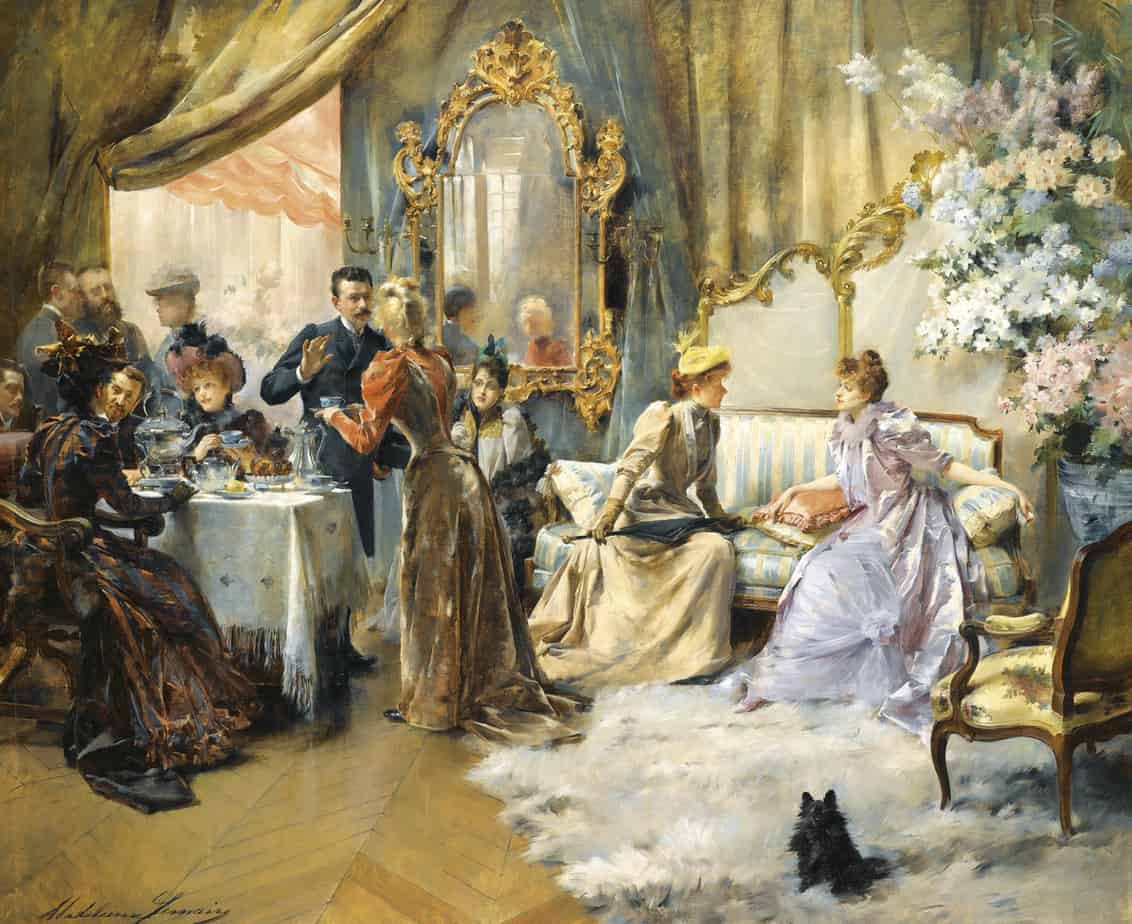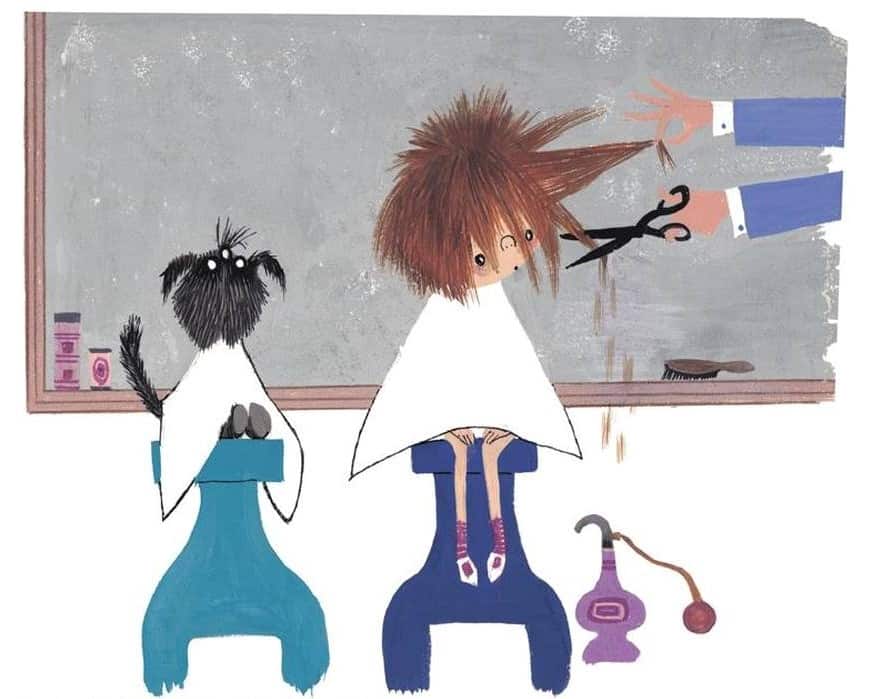First, what is a salon?
1. A RECEPTION ROOM IN A LARGE HOUSE
The common feature of a salon: It is set up for social interaction.

As shown in the header illustration, “Grand Salon” Hôtel du Collectioneur, Paris 1925. Arch. Emile Jaques Ruhlmann, a salon is also a feature of a grand hotel.
2. WHERE A HAIRDRESSER / BEAUTICIAN / COURTIER CONDUCTS TRADE
(A courtier is often in attendance at the court of a monarch or other royal personage. They’re not all noble, because courtiers include the clergy, soldiers, secretaries and so on.)

3. THE LITERARY SALON WHICH STARTED IN FRANCE
Innovation is driven by the recombination of ideas. So the larger a population you have and the more interconnected it is, the more ideas can flow among diverse minds and create baby ideas. … Jeffrey West … in his book Scale tries to make this case that just getting a bunch of people together in the same place, talking to each other is a huge accelerant to new ideas
Sean Carroll and Joe Henrich in conversation
The literary salon originated in seventeen-century France and was the birthplace of conte de fées: fairy tales, in which the ‘fairies’ are magical creatures.
Charles Perrault, along with other men, is remembered today as a significant figure in establishing this genre of story but, as often happens in historical accounts of important figures, it was actually women who mostly hung out in these French salons, interacting, swapping stories and talking about literature. The fairy stories functioned as commentary on power structures and wealth.
In the 1630s, the Marquise de Ramboillet owned a salon in Paris called Chamber bleue. Highly educated women from aristocratic families gathered there. They were called the précieuses. In contemporary English, this loanword now refers to a pretentious woman who puts on airs, which should tell us a lot about how we feel, as a culture, about women who are genuinely smart: Fakers.
Later that century, one of the woman authors of these new fairy tales started to make a splash. Her name was Marie-Catherine d’Aulnoy. In 1690 she released “The Island of Happiness”. (It was novel-length.) Seven years later she released four volumes of conte de fées, Tales of the Fairies (1697), establishing her for centuries as a significant figure in European fairytale history. It was actually D’Aulnoy who coined the term conte de fée.
D’Aulnoy had reason to be interested in fairytales as a vehicle to express emotions around gender injustice. She had been married off at 15 to an abusive man three decades older. Like all women of her time, she could not inherit, and could not work to earn money.
Seventeenth century France is known for its ‘gender wars’. During this century a number of all-male academies were being founded. Women quite rightly felt marginalised and saw the need for a revolution.
Today, fairytales which all end with the heroine marrying the man she loves seem retrograde, but marrying for love was itself a radical idea in the context of a culture which married its girls off and gave them no autonomy whatsoever to marry who they wanted to spend the rest of their lives with.
The Quarrel of the Ancients and the Moderns began in 1687. The ‘ancients’ were all about Greco-Roman literary archetypes. In opposition, the ‘moderns’ praised archetypes from French folklore and from medieval, courtly tradition. In case you’re wondering, Charles Perrault was on the side of the Moderns. His fairy tale “Griselda” (1691) was written to exemplify his modern views. Perrault was publishing fairy tales at the same time as Marie-Catherine D’Aulnoy.
The most frequent attack on women throughout the Middle Ages was on grounds of insubordination. The proper behavior of women was depicted in many tales of ‘patient Griselda,’ who accepts her husband’s verbal and physical abuse with love and fortitude and thereby wins his love. The politics are clear even if the psychology is flawed. Even today, a woman’s desire for a life of her own is interpreted by many men as an assault against them.
Beyond Power: On Women, Men & Morals by Marilyn French p 122
Excluded from The Establishment, aristocratic French women decided to start their own private space for recitations, performance and general storytelling. Fairy tales are perfect for this kind of storytelling because they sit between the oral tradition, can easily incorporate aspects of pop culture and also classical literary traditions of the so-called elite. A fairytale can be anything the storyteller wants it to be, because the backbone of plot is so robust. The form is also very welcoming; you don’t even have to know how to read and write to have a solid appreciation of fairytale.
I don’t want to make these aristocratic women seem too liberal. I mean, they were still wealthy white women practising wealthy white feminism in their private salons. The stories they used as base were from ‘the common folk’, but they weren’t interested in inviting the actual common folk to these salons. They didn’t want to be associated with the nursemaids and peasant women of the world. Charles Perrault was happy to write about such women because he didn’t need to worry about being taken for one. In contrast, the female salonnieres preferred reciting fairytales starring sibyls and fairies. These ladies were fans of Giambattista Basile (1566 – 1632) and Giovanni Francesco Straparola. Basile was an Italian fairytale collector remembered today for the earliest known European versions of Rapunzel and Cinderella. Straparola (1485?-1558) was also Italian. He published a collection of stories in two volumes called The Facetious Nights or The Pleasant Nights. This collection includes some of the first known printed versions of fairy tales in Europe, as they are known today. We don’t know much about him, partly because Strapola is unlikely to have been his real name.
Fast forward to the time of the Grimms, who today catch a disproportionate amount of the credit for tales they collected (largely from women), and who dismissed the fairy tales of D’Aulnoy for being sentimental, feminine and domestic in nature. Before the Grimms came along, D’Aulnoy’s work was hugely popular, and distributed in translation all across Europe in The Fairies Cabinet (1785-89). Andrew Lang was happy to include a number of her stories in his Fairy Books. In contrast, renowned misogynists the Grimm Brothers actively sought to minimise the importance of D’Aulnoy in fairy story tradition, and they were successful in their mission. How many readers know of the Grimm brothers (and Charles Perrault) but not the name of Marie-Catherine D’Aulnoy today?
When she is mentioned, she is often positioned as secondary to the male actors in the history of fairy tale. Note the wording of the following sentence from Britannica online:
Her best-remembered works are Contes de fées (1697; “Fairy Tales”) and Les Contes nouveaux ou les fées à la mode (1698; “New Tales, or the Fancy of the Fairies”), written in the manner of the great fairy tales of Charles Perrault but laced with her own sardonic touch.
Britannica

